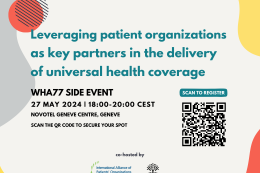An African Medicines Agency - any room for African patients engagement?
Board Member Joshua Wamboga reports from the World Health Organization Africa's 66th Regional Committee meeting held in Addis Ababa, Ethiopia, 19-23 August 2016
Saving the best for last 
Africa has a way of dragging out the best for last when it comes to important discussions on health. The World Health Organization’s 66th African Regional Committee meeting held in Addis Ababa Ethiopia, 19-23 August 2016, waited for day 4 to open up the most important item on its agenda. Item 18 invited the Member States to discuss a regional strategy on the regulation of medical products in the African Region.
The Member States agreed, and IAPO’s African members will no doubt concur with this, that medical products play an important role in the prevention and management of disease, saving millions of African lives each day. However, circulation of 'substandard non-quality assured, spurious, falsely-labelled, falsified and counterfeit' (SSFFC) medical products on the continent undo these benefits.
The SSFFCs on sale in the African market may be manufactured locally or imported into the country. WHO AFRO says that their presence in the market indicates a weak regional regulatory and enforcement capacity, particularly weak post-market surveillance.
Elsewhere, there is also a problem in introducing new innovative drugs into the African market. This is once again a regulatory failure as timelines in reviews and approvals of clinical trials and registration of products delay access to innovative medical products of good quality.
The scale of the SSFFCs problem facing Africa today is clear. If you go into any retailer and market today, you will find SSFFC medical products on sale. Some markets are awash with them! Who makes them, under which regulations are they allowed in and, most importantly, who is turning a blind eye to this manufacturing and trade?
The double tragedy is that the crime syndicates that bring in SSFFCs into Africa may also be robbing Africa of its wildlife; their shipping containers will return back with illegal ivory, rhino-horn and other wildlife products that are banned under Convention on International Trade in Endangered Species of Wild Fauna and Flora.
Big bold solution-an African Medicines Agency
The 66th WHO AFRO Regional Committee agreed that the regulation of the manufacturing, importation and sale of medical products on the continent now needs new and bolder solutions.
Manufacturing had been dealt with by the Pharmaceutical Manufacturing Plan for Africa (PMPA) that was endorsed by Heads of State and Government at a summit in Accra in 2007. Now it is time to deal with the regulation of medicines.
The first innovative solution that the WHO AFRO Regional Committee is proposing is that Africa should set up an African Medicines Agency (AMA). This body should mirror the European Medicines Agency (EMA) which oversees regulation of pharmaceutical manufacturing and trade in the European Union (EU). Linking economics and public health is the first innovative step in regulating medicines in Africa. The EMA works very closely with the EU; the EU began its life as the European Economic Community (EEC).
The thinking behind this, and within the EU Treaty, was that SSFFCs are not only a patient safety and public health problem, they are also a serious economic matter threatening regional manufacturing and trade in medicines. SSFFCs damage health and the legitimate pharmaceutical manufacture and trade in the region. It is proposed that the AMA, when set-up, will work closely with, and be embedded within, regional bodies such as:
- Common Market for Eastern and Southern Africa (COMESA)
- East African Community (EAC)
- Southern African Development Community (SADC)
- Economic Community of West African States (ECOWAS)
Phase two: capacity building and strengthening of NMRAs
The second phase of this solution is that the AMA and the regional economic bodies will then collaborate with the individual Member States in undertaking capacity building exercises to strengthen their National Medicines Regulatory Authorities (NMRAs). This is the difficult part, requiring a change in culture.
AMA and the regional economic bodies will prioritise regional and national programmes to improve the governance of regulatory systems, increase collaboration, harmonise standards and work together on regulatory activities by strengthening the capacity of NMRAs to improve patient access to safe medical products of good quality nationally.
The vision is that the AMA, just like the EMA that has harmonised medicines regulation in over 30 EU and EEA countries in Europe, will help Africa achieve a medicines market that is safe, quality-assured, well-regulated, participatory, transparent and accountable.
Patient engagement in AMA - the missing strategy!
What I found missing from the AMA debate and strategy was that there was very little room for patient engagement within the decision-making process at this early stage. The EMA has had a patient engagement programme from the outset which has set standards for all. EMA's 2016 engagement activity report reflects the kind of patient engagement activities that we may need from the AMA. Africa needs early patient insight and patient involvement to make this a success.
Will the AMA follow these standards of patient engagement? It is up to us now to push for and help shape this exciting initiative to achieve a patient-centred AMA!



